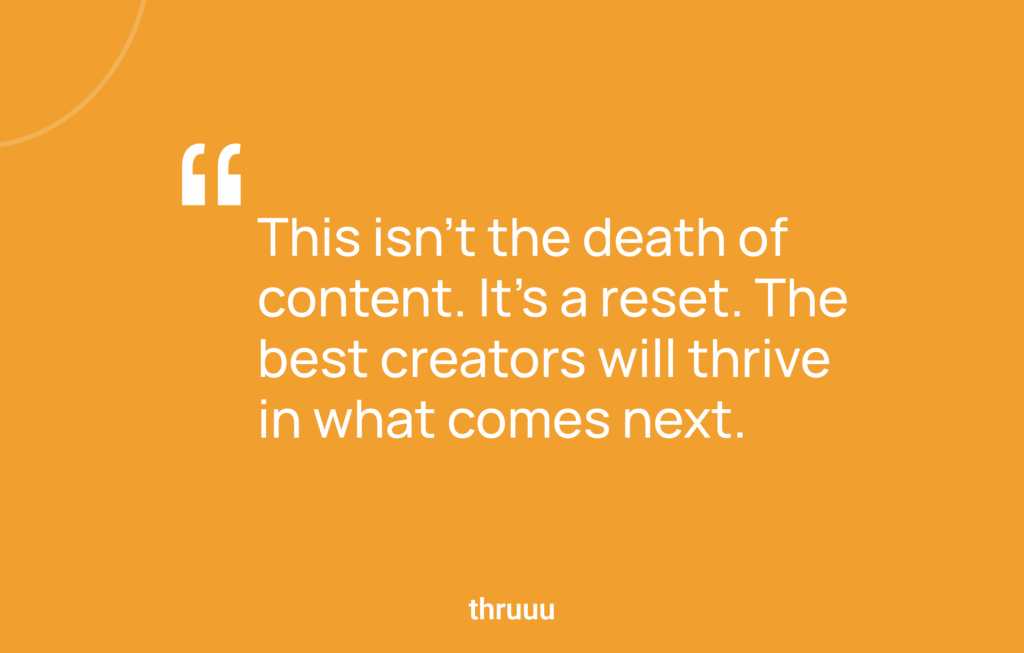Ryan Law, Director of Content Marketing at Ahrefs, shook the table on LinkedIn a few weeks ago, questioning the future of educational content.
He pointed out the absurdity of many SaaS sites doubling as second-rate Wikipedia, not because they helped users but because they gamed Google.
Jenna St John, Head of Content at Grizzle, responded sharply in her post: Educational content isn’t dying—it’s evolving and probably sick of being treated like a traffic hack.
Their posts sparked a debate on LinkedIn, with content folks throwing elbows, sharing insights, and offering some much-needed honesty from every angle.
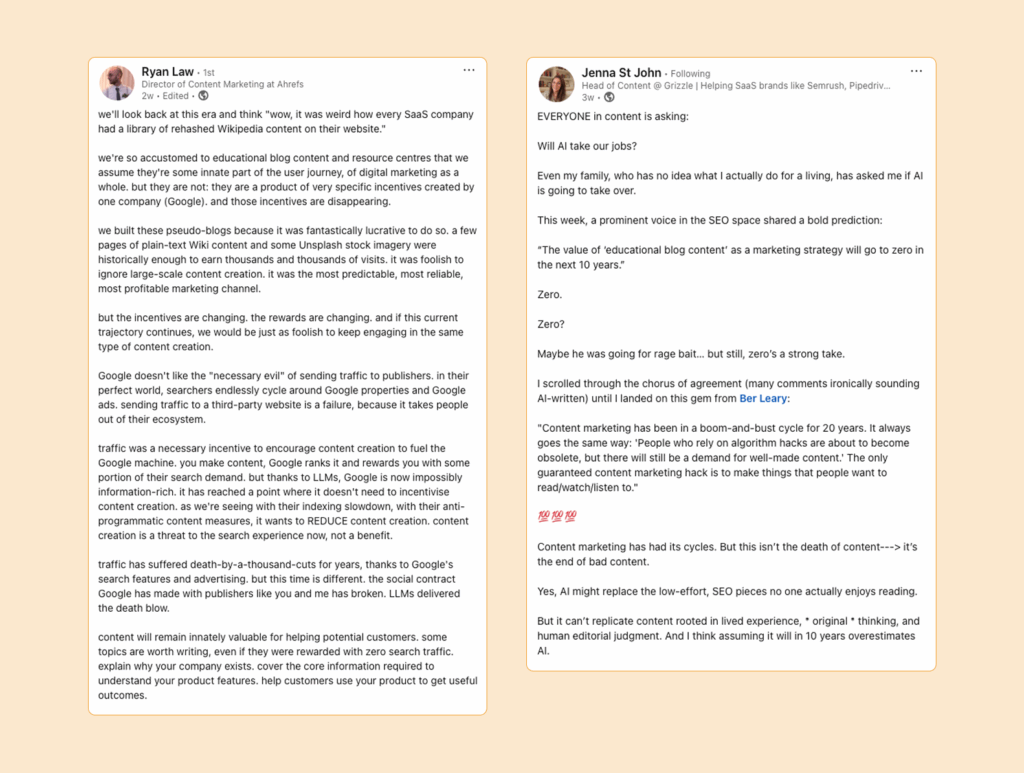
Our piece of content pulls together the most valuable insights from that conversation.
It also discusses whether educational content is truly dead and what it means for anyone who wants to remain relevant in this age of AI Overviews and LLMs, which are reducing clicks.
Let’s get into it!
Table of Contents
The End of SEO-Driven Content?
For years, SaaS companies have built sprawling blog libraries with informational articles, such as “What is X?” and “How to do Y?”
Google’s incentives drove this strategy: create content, get ranked, and receive traffic.
However, with the introduction of AI Overviews, large language models (LLMs), and now AI mode, Google’s need for such content has diminished.
Ryan Law puts it like this,
“We’ll look back at this era and think ‘wow, it was weird how every SaaS company had a library of rehashed Wikipedia content.
We’re so accustomed to educational blog content and resource centres that we assume they’re some innate part of the user journey and digital marketing. But they are not: They are a product of specific incentives created by one company (Google), and those incentives are disappearing.
…but the incentives are changing. The rewards are changing, and if this current trajectory continues, we would be just as foolish to keep engaging in the same type of content creation.”
Read the full LinkedIn post here.
This shift indicates a “social contract” termination between publishers and Google.
The previous mutual benefit of content creation in exchange for traffic is eroding.
Joshua Okey-Ogunjiofor, a content writer at Campfire Labs, reiterated that Google no longer has incentives to reward sites creating educational content that AI can spit out in 10 seconds without typos or sleep.

But does Google no longer need content?
It’s Not the Death of Content… It’s the Death of Bad Content
Google can’t create content. It will continually rely on content from publishers and creators as source materials for its AI Overviews and AI mode answers.
But this time, you must step up your game by creating content that outclasses the status quo to remain relevant.
Jenna explains it as content rooted in lived experience, original thinking, and human editorial judgement.

Read the full LinkedIn post here.
Puneeth Ghodgeri, Head of Marketing at Superblocks, also said, “Authentic, distinctive custom content is what will separate the great from the good.”
Let’s fall back to Google’s recent documentation on ensuring your content performs well in their AI experiences on Search.
Their first point was “Focus on unique, valuable content for people.”
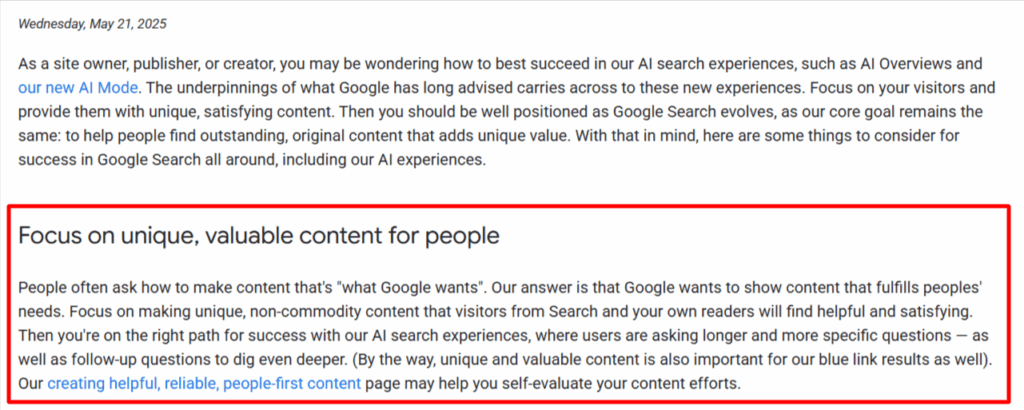
Google validates that, despite the evolution of AI, valuable content tailored to meet people’s needs will stand out.
Ber Leary, Content Consultant at Helios HR, mentioned a growing demand for well-made content that people want to bookmark, read, and share with friends.
“Content marketing has been in a boom-and-bust cycle for 20 years. It always goes the same way: ‘People who rely on algorithm hacks are about to become obsolete, but there will still be a demand for well-made content.’ The only guaranteed content marketing hack is to make things people want to read/watch/listen to.”
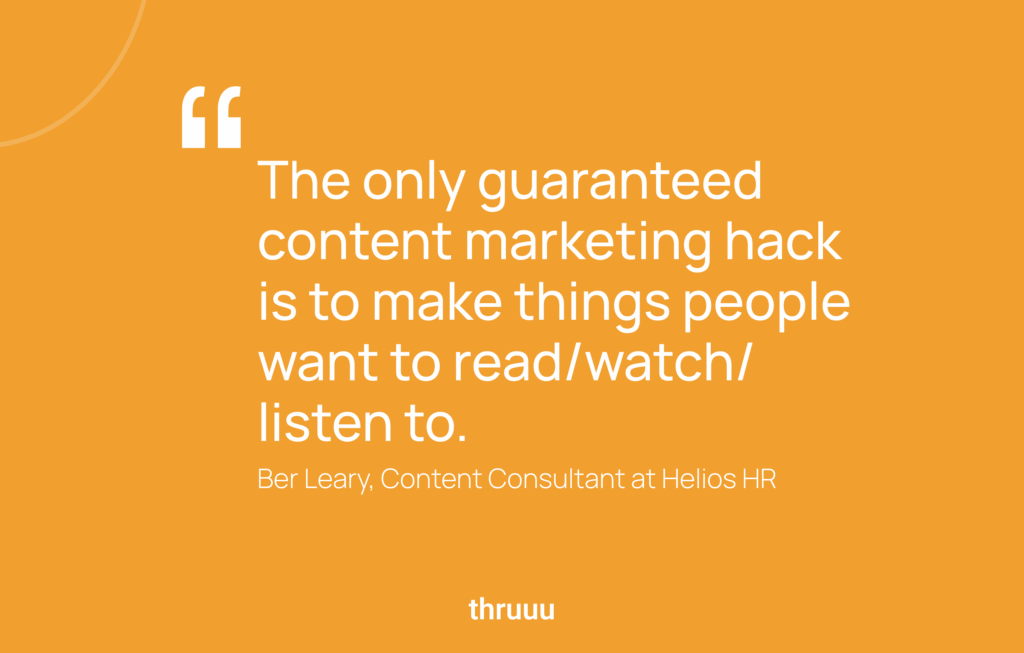
This content type isn’t just random tips that leave readers in the dark on figuring out their way.
So instead of writing on “What is SEO?” create educational content on “Your SEO playbook that increased a client by X results.”
Tommy Walker, Founder of The Content Studio, explains it well. He said,
“Does that mean we don’t create the educational type stuff? No, I don’t think so, but it should be closer to what Ahrefs does, where it’s “here’s how you do it with us” rather than, “here’s how you do it, and we happen to sell a thing that helps.”
I asked Stephanie Trovato, CEO at Big H Content, if Google no longer needs content and may even be trying to reduce it.
She responded with this intriguing insight,
“I wouldn’t say Google doesn’t need content. It still relies on it to train models and surface answers, but it’s pretty clear they’re trying to show people answers without sending them to our sites.
And yeah, that can suck. It feels like we’re all working for free sometimes. But Google still needs good content. It’s just filtering out anything that looks low-effort or the same old.
So if you’re putting out stuff that helps people, you’re still in the game. But filler content? That’s getting trimmed.”
That means if you still create generic walls of text that just provide basic answers, you’ll stay long in SERPs’ darkroom.
Why Great Content Will Matter Even More in the AI Era
Imagine walking into a food court where every stand serves plain white bread—no butter, no jam, just dry slices stacked like sad Jenga towers.
Then, one stall serves crispy Nashville hot chicken on a warm, buttered biscuit, dripping with honey and heat—the combo that makes you forget every tasteless food you’ve ever eaten.
That’s what quality content feels like right now. When the web is full of regurgitated junk, content with authenticity and first-hand knowledge that walks readers through the solution bridge will stand out.
That is why John Iwuozor, Content Marketer and Writer for B2B SaaS, stated in his recent LinkedIn post that great writers with expertise in specific industries who can turn complex topics into clear content will be valuable in this AI era.

More so, AI still needs source material which gives original content long-term leverage.
Perplexity gathers insights from top-tier sources on the SERPs to generate its answers.

ChatGPT has also historically relied on Bing Search as an information source.
So, Jenna St. John’s view that great content retains its relevance irrespective of AI evolution remains.
She said,
“An internet devoid of educational content is also a bit of a ‘snake eating its tail’ problem. LLMs still rely on human-made content to train and stay relevant.”
Milica Vidojkovic, Social Media Manager at Alchemy Crew, also reinstated Jenna’s point.
“I agree AI will change the game, but AI needs quality content to exist, yet some predict that content will have zero value. It’s like saying libraries will make books worthless. The real question is: What happens when AI runs out of good human content to learn from? Will that ever happen?”
Marston Gould, Director SEO at A Place for Mom, added,
“LLMs will become less diverse. If no one creates high-quality sources, trust in AI answers will erode.”
Jenna concluded her post with a foresight that a few people have been discussing. She mentioned governmental bodies tightening content scraping regulations.

No matter what happens, content fueled by original thinking and tailored toward solving readers’ pain points will remain relevant.
Martin Jeffrey, Founder of Clickability, explained it well in his reply to Jenna’s post.

So, what is the future of content marketing?
The Future Is Not 1000+ Blog Posts in One Click
As generic SEO-driven content loses effectiveness, the new playbook isn’t about publishing more; it’s about publishing better.
The goal is no longer keyword coverage at scale. It’s clarity, connection, and product alignment.
Stephanie Trovato said the future of content is content that has a pulse.
She says, “If your content could’ve been written by a robot, it probably will be replaced by AI. But content with a pulse, i.e., brings something new — your experience, a strong opinion, customer insight, real data — is still valuable. That’s what people share, link to, and remember. So yeah, depth, perspective, and usefulness all matter more than ever.”
Here’s an overview of how to create content that will remain relevant in the coming days.
Explain Your Product Better
Create more bottom-of-the-funnel content that explains how your product solves real-time user problems.
Ryan Law expanded it well. He said, “Content will remain innately valuable for helping potential customers. Some topics are worth writing about, even if Google rewards them with zero search traffic. Explain why your company exists. Cover the core information required to understand your product features. Help customers use your product to get useful outcomes.”
Additionally, create detailed product documentation that clearly explains the intricacies of your product and serves as a source of information for LLMs’ product-related answers.
Taylor Scher, Founder at Taylor Scher Consulting, said, “Those product-specific how-tos are extremely underrated. Even when a user prompts an LLM like ‘how to add text to a PDF,’ the PDF will list the best tools to do this with and explain the exact process, usually drawing from your product documentation. I’ve even seen them link directly to the signup page. It’s a very underrated play at the moment.”
Educate Your Users With Depth and Empathy
Content that would work isn’t a rehash of what is already online.
Instead, it’s a compilation of choice words fueled by in-depth research and created for genuine usefulness.
Also, your content should appear like a coffee chat with the readers, with the primary purpose of solving their problems in easy-to-understand words.
Create content for your audience, not just to sell your product.
Hersh Gaud says it well.

Build Authority Through Real Thought Leadership
Do you have a different point of view from a popular belief or strategy?
Create a thought leadership piece with proof to back up your points.
Opinion-based content will thrive in the coming days compared to the “SEO kind” content.
Tell Stories That Connect Emotionally With Your Audience
Stories evoke emotion and connect deeply. You must inculcate the painting of the picture of your readers’ pain point with relatable stories in your content.
People want to connect, feel, and consume content that matters, and stories matter.
Stories that resonate with readers’ experiences establish you as an expert and increase the trustworthiness of your content.
Create Content for Different Search Intent
Google confirms in its recent documentation about succeeding in AI search that users ask new and complex questions.

Additionally, a recent Semrush study found that only 30% of ChatGPT’s prompts align with the four known types of search intents: informational, navigational, commercial, and transactional.
The other 70% are entirely new search intents:
- Problem-solving
- Brainstorming
- Exploratory inquiries
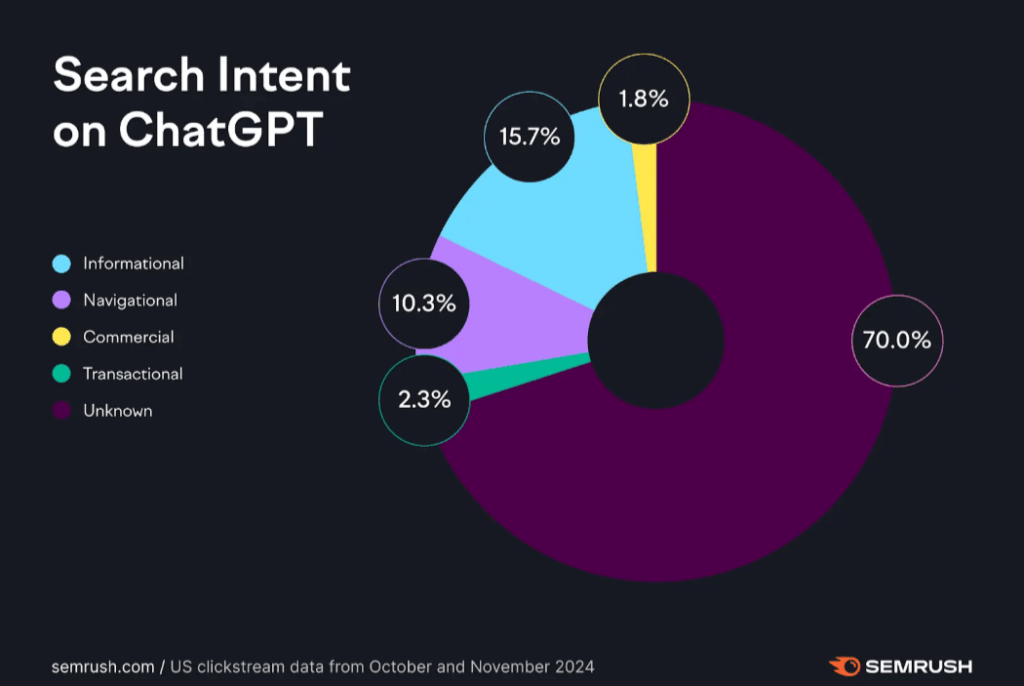
The fact that there are new search behaviours means your content strategy needs to serve other types of content. Create:
- Listicles with explicit brand mentions and context
- Step-by-step guides and tutorials (with visuals or short videos)
- Use-case driven case studies (how others solved the same problem)
- Comparisons and frameworks (e.g., “Notion vs. Evernote vs. Google Keep — who wins at what?”)
- First-person walkthroughs or journeys (e.g., “What I learned using X for 30 days”)
- Roundups from experts (e.g., “15 designers share their go-to mood board tips”), etc
Focus on Topics Relevant to Your Company
Ryan Law said something interesting in his post.
“Most content marketing today has expanded into topics irrelevant to the company’s products and beliefs. It is just information arbitrage – and LLMs are much better at arbitrage than we are.”
Guess what?
Most traffic from topics irrelevant to your company looks good in dashboards but rarely converts.
The loss is mostly noisy.
A notable example is the decline in HubSpot traffic. Research showed that many of the pages that lost their traffic were for keywords outside the brand’s horizon and likely did nothing for the business.
Why create them at the first instance?
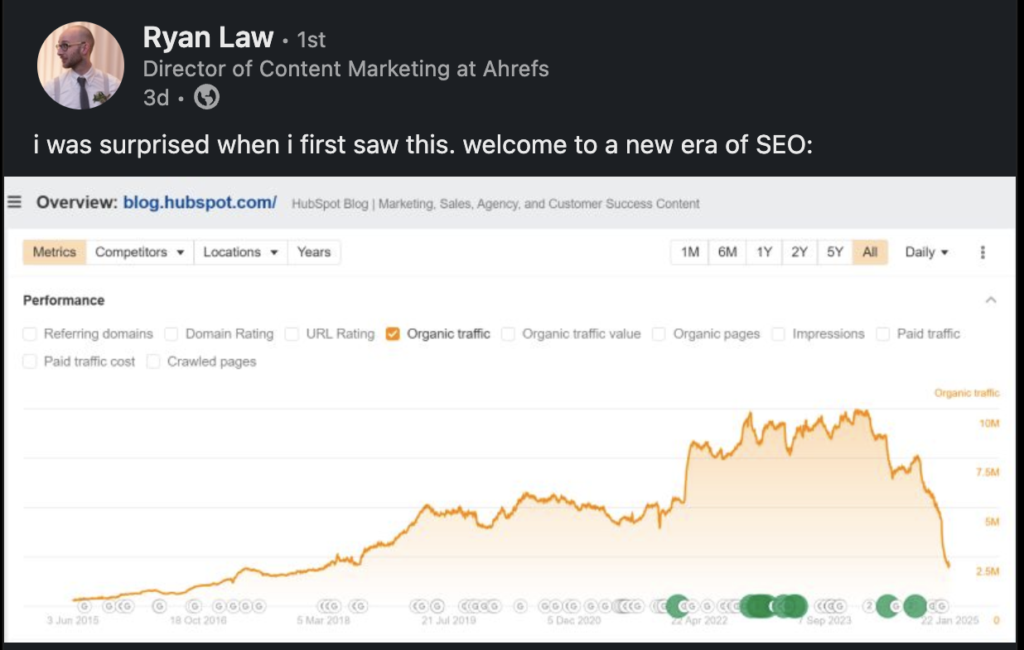
Prioritize topics that align with your product solutions and your audience’s pain points.
Leverage High-Relevance Content Formats for the AI Era
Bonus tips: In response to Ryan’s post, some content folks shared some content formats with high relevance potential in this AI age:
1. User-generated content skewed heavily towards the bottom of the funnel
Ayomide Joseph A, a BOFU SaaS content writer, puts it this way.

2. Creative and entertainment content in B2B
Ronnie Higgins, Senior Content Production Manager at Freshpaint, explained it explicitly in his comment.

3. Intent-based content
Here’s how Puneeth Ghodgeri puts it: A sharp take on why intent-based, original content matters more than ever in the age of AI.

How do you remain relevant irrespective of the evolution of AI?
Follow the new content playbook.
The New Content Playbook: Smaller, Smarter, More Human
The age of mass production, just to exercise your writing muscle, is over.
Your content must focus on:
- Helping your readers
- Creating memorable perspectives
- Building an authority AI can’t mimic.
Stephanie Trovato adds more context: “The new content playbook is pretty straightforward: talk to people, figure out what they actually care about, and create stuff that helps them do something. Don’t try to play the algorithm game; create something useful. Use AI to help brainstorm or get unstuck, but the ideas and structure still come from real conversations, not tools.”
And finally…
“This isn’t the death of content. It’s a reset. The best creators will thrive in what comes next.”
